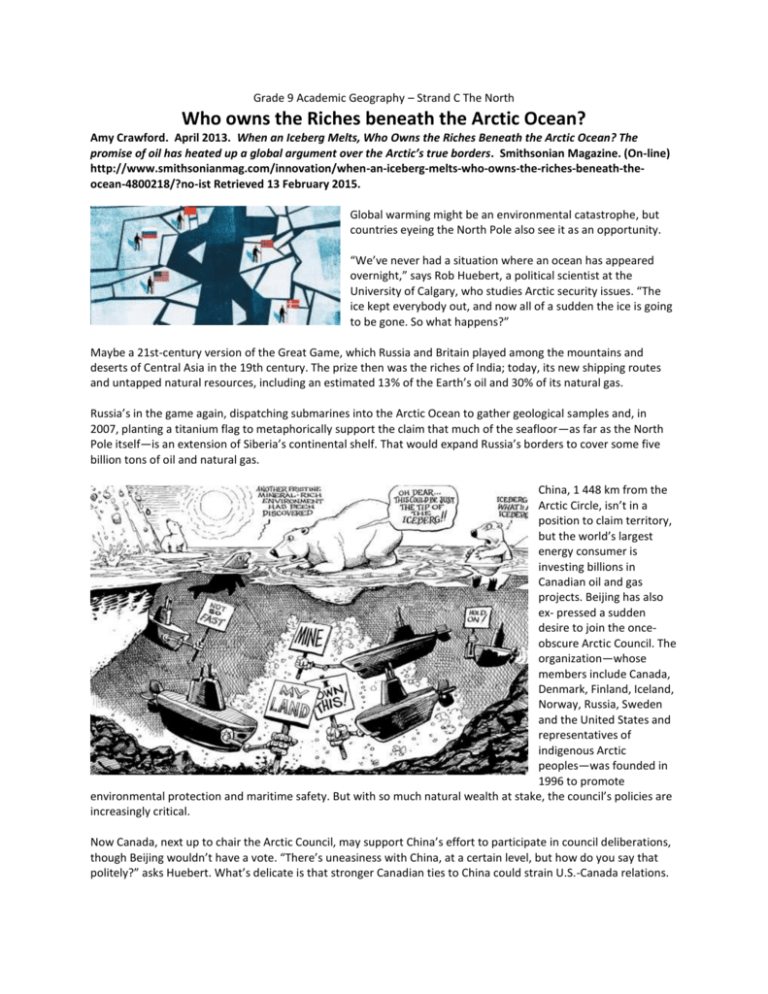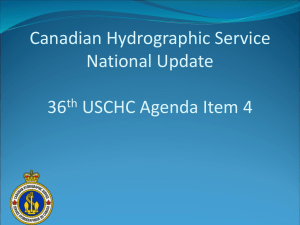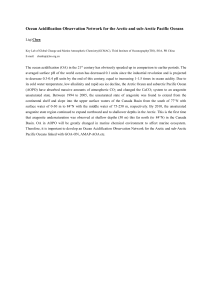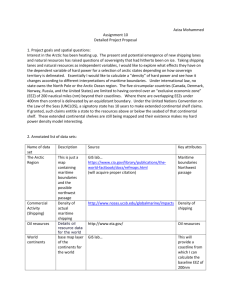Lesson 6 - Who owns the Arctic
advertisement

Grade 9 Academic Geography – Strand C The North Who owns the Riches beneath the Arctic Ocean? Amy Crawford. April 2013. When an Iceberg Melts, Who Owns the Riches Beneath the Arctic Ocean? The promise of oil has heated up a global argument over the Arctic’s true borders. Smithsonian Magazine. (On-line) http://www.smithsonianmag.com/innovation/when-an-iceberg-melts-who-owns-the-riches-beneath-theocean-4800218/?no-ist Retrieved 13 February 2015. Global warming might be an environmental catastrophe, but countries eyeing the North Pole also see it as an opportunity. “We’ve never had a situation where an ocean has appeared overnight,” says Rob Huebert, a political scientist at the University of Calgary, who studies Arctic security issues. “The ice kept everybody out, and now all of a sudden the ice is going to be gone. So what happens?” Maybe a 21st-century version of the Great Game, which Russia and Britain played among the mountains and deserts of Central Asia in the 19th century. The prize then was the riches of India; today, its new shipping routes and untapped natural resources, including an estimated 13% of the Earth’s oil and 30% of its natural gas. Russia’s in the game again, dispatching submarines into the Arctic Ocean to gather geological samples and, in 2007, planting a titanium flag to metaphorically support the claim that much of the seafloor—as far as the North Pole itself—is an extension of Siberia’s continental shelf. That would expand Russia’s borders to cover some five billion tons of oil and natural gas. China, 1 448 km from the Arctic Circle, isn’t in a position to claim territory, but the world’s largest energy consumer is investing billions in Canadian oil and gas projects. Beijing has also ex- pressed a sudden desire to join the onceobscure Arctic Council. The organization—whose members include Canada, Denmark, Finland, Iceland, Norway, Russia, Sweden and the United States and representatives of indigenous Arctic peoples—was founded in 1996 to promote environmental protection and maritime safety. But with so much natural wealth at stake, the council’s policies are increasingly critical. Now Canada, next up to chair the Arctic Council, may support China’s effort to participate in council deliberations, though Beijing wouldn’t have a vote. “There’s uneasiness with China, at a certain level, but how do you say that politely?” asks Huebert. What’s delicate is that stronger Canadian ties to China could strain U.S.-Canada relations. The United States and its northern neighbor are also at odds over the Northwest Passage, a storied route along Arctic North America that became free of ice along its entire length for the first time in August 2007. The passage is at least 6 500 km shorter than the usual sea route through the Panama Canal, and cuts travel time by two weeks— a potential boon to major exporters like China. While Canada insists that part of the passage falls within its borders, the United States and Europe counter that it’s an international waterway. On the other side of the Arctic Ocean, Russia claims ownership of the Northeast Passage, which since 2008, has been consistently navigable during the summer and early fall, allowing ships to take a shortcut between Asia and Europe. In 2011, two Finnish tankers navigated the passage, demonstrating the potential for faster transport of oil to Pacific countries. But don’t expect new Arctic gushers anytime soon. Some energy companies have canceled exploration programs because of high costs, and engineers are struggling to design technology that can withstand the harshest northern environments. Even as the ice melts, the Arctic will not give up its riches easily. King, Hobart. (undated). Who owns the Arctic Ocean? (On-line) Geology.com http://geology.com/articles/who-owns-the-arctic.shtml Retrieved February 13, 2015. An Energy and Mineral Resource Treasure Who owns the Arctic Ocean and any resources that might be found beneath those waters? This question has enormous economic significance. The United States Geological Survey estimates that up to 25% of the world's remaining oil and natural gas resource might be held within the seafloor of the Arctic Region. Significant quantities of other mineral resources might also be present. Control of Arctic resources is an extremely valuable prize. These resources become more accessible as global warming melts the sea ice and opens the region to commercial navigation. Freedom of the Seas Since the seventeenth century a "freedom of the seas" doctrine was accepted by most nations. This doctrine limited a nation's rights and jurisdiction to the narrow area of sea along the nation's coastline. The remainder of the ocean was considered as common property that could be used by anyone. This was before anyone had the ability to exploit offshore resources. Then in the mid-1900's concerns that long-distance fishing fleets were depleting coastal fish stocks triggered a desire in some nations to have greater control over their coastal waters. Then oil companies became capable of drilling in deep water and ideas for the seabed mining of manganese nodules, diamonds and tin-bearing sands started to seem possible. Any nation that claimed a greater distance from shore also made claim to valuable seafloor resources. Unilateral Claims In 1945, the United States announced that it assumed jurisdiction of all natural resources out to the edge of its continental shelf. This was the first nation to depart from the freedom of the seas doctrine and other nations quickly followed. Nations began making unilateral claims to seafloor resources, fishing grounds and exclusive navigable zones. New “Law of the Sea” The United Nations sought to bring order and equity to the diversity of claims being made by nations around the world. In 1982, the United Nations treaty known as "The Law of the Sea" was presented. It addressed navigational rights, territorial waters limits, exclusive economic zones, fishing, pollution, drilling, mining, conservation and many other aspects of maritime activity. With over 150 nations participating, it was the first attempt by the international community to establish a formal agreement on how the seas can be used. It also proposes a logical allocation of ocean resources. Exclusive Economic Zones Under the Law of the Sea, each country receives exclusive economic rights to any natural resource that is present on or beneath the sea floor out to a distance of 200 nautical miles (371 kilometers) beyond their natural shorelines. In the Arctic, this gives Canada, the United States, Russia, Norway and Denmark a legal claim to extensive sea floor areas that might contain valuable resources. NOTE: As of April 2012, the United States had not yet ratified the Law of the Sea treaty. Those who have opposed ratification say that it would limit United States sovereignty. The International Boundaries Research Unit at Durham University has prepared a map showing the potential maritime jurisdiction and boundaries of the Arctic region if the Law of the Sea treaty is put fully into effect. Continental Shelf Areas In addition to the 200 nautical mile economic zone, each country can extend its claim up to 350 nautical miles (650 km) from its shoreline for those areas that can be proven to be an extension of that country's continental shelf. To make this claim, a nation must acquire geological data that documents the geographic extent of its continental shelf and submit it to a United Nations committee for consideration. Most countries with a potential claim to the Arctic are currently mapping the seafloor to document their claim. Who Owns the Lomonosov Ridge? One feature of the Arctic Ocean that is of special note is the Lomonosov Ridge, an underwater ridge that crosses the Arctic Ocean between the New Siberian Islands and Ellesmere Island. Russia is trying to document that the Lomonosov Ridge is an extension of the Asian continental shelf, while Canada and Denmark (in regards to Greenland) are trying to document that it is an extension of the North American continental shelf. Any country that can successfully establish such a claim will gain control of a vast amount of seafloor resources in the central portion of the Arctic Ocean. Looking Forward In the future, as sea levels rise, current shorelines will migrate inland and the 200 nautical mile economic zone will move inland with them. In areas with gently sloping coastal land this landward advance of the sea could be a significant distance. Perhaps those nations should exploit their most seaward resources first? In summary, the Law of the Sea Treaty grants significant undersea portions of the Arctic to Canada, the United States, Russia, Norway and Denmark. These nations gain claim the natural resources on, above and beneath the ocean floor up to 322 km from their shoreline. They can also extend their claim up to 563 km from shore for any area that is proven to be a part of their continental shelf. All of these nations have gained significant oil and natural gas resources as a result of this treaty.








